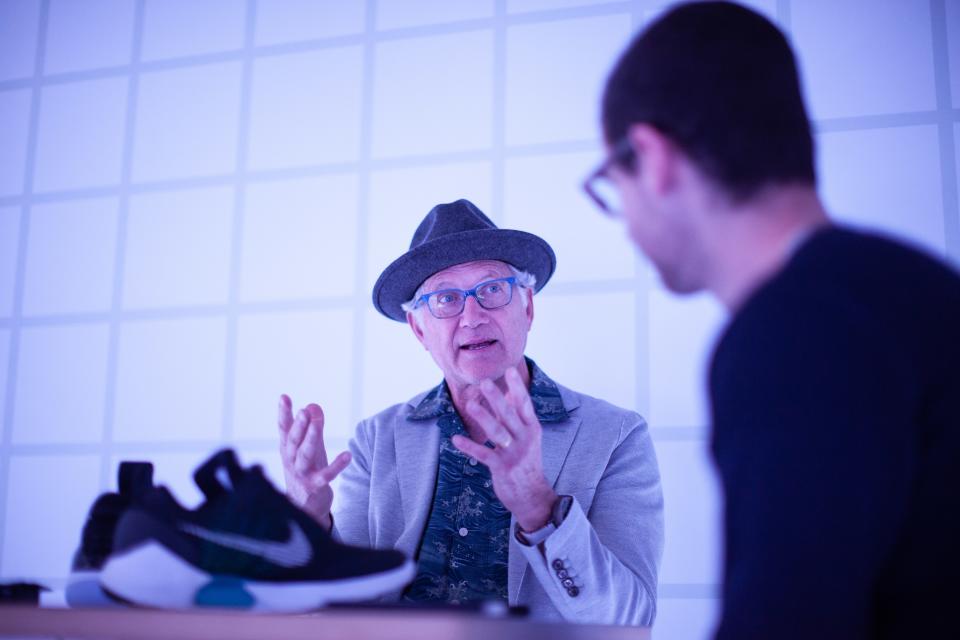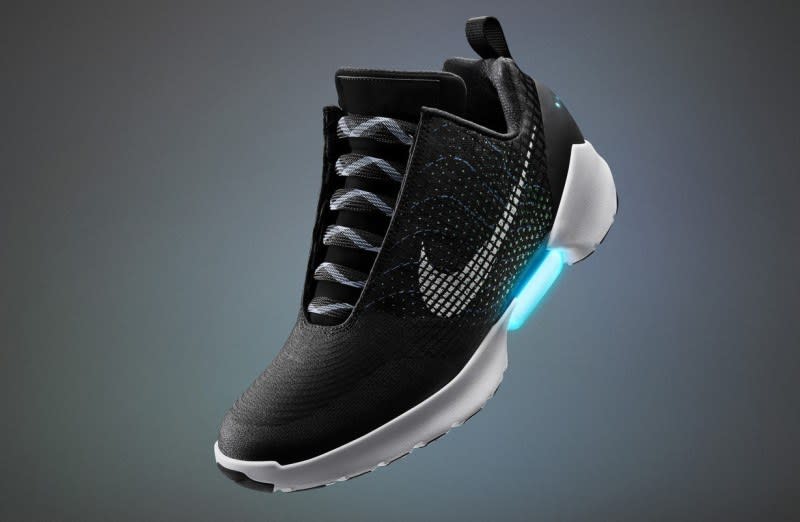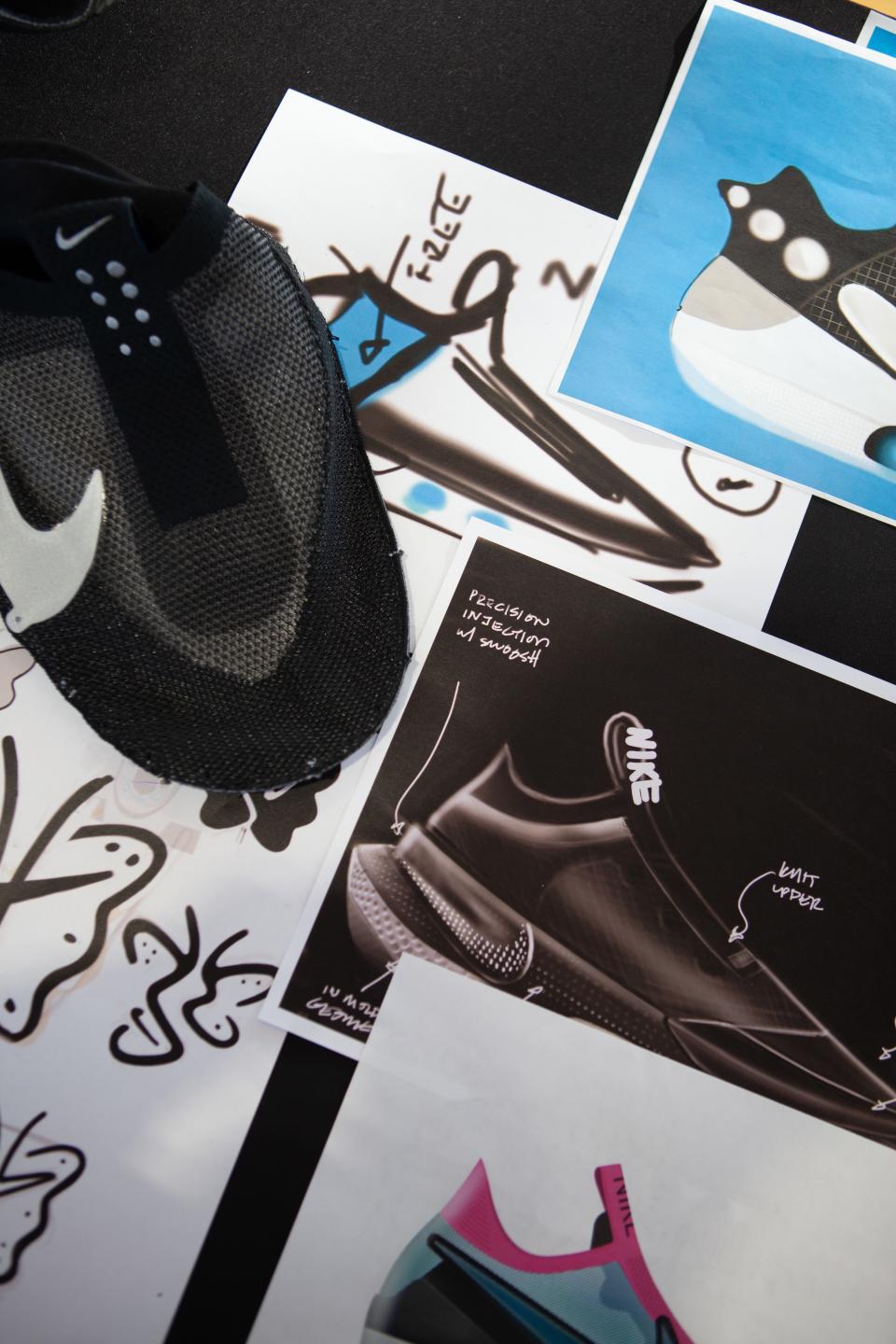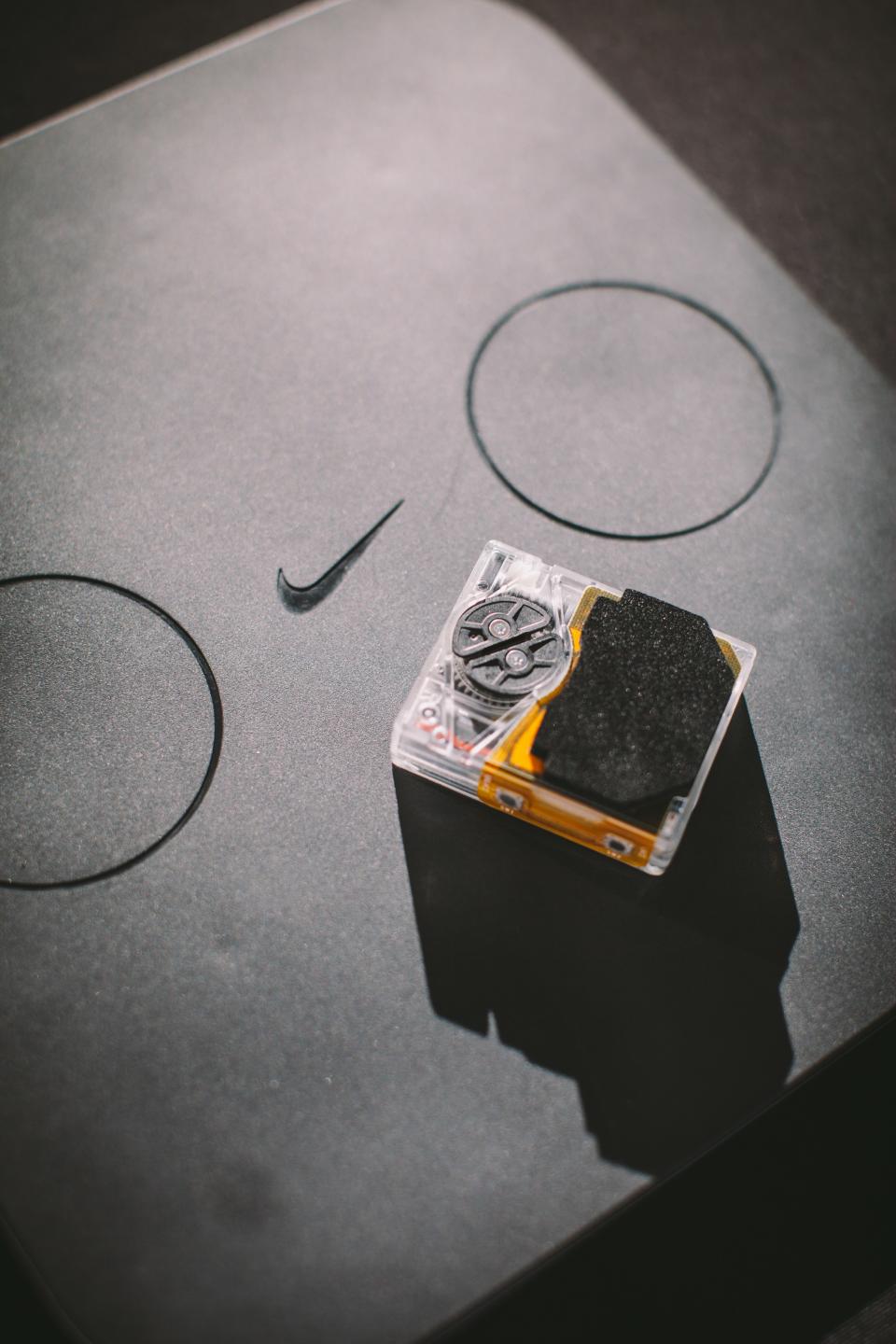Nike's New Self-Lacing Sneaker Is Back from the Future—and Now for Everyone
1. It’s Got to Be the Sound
“The shoes sounded like a cat that had its tail run over by a bicycle,” Tinker Hatfield said. The designer and I were sitting in white Kubrickian cube seemingly airdropped into the middle of the Mia Hamm building on Nike’s Beaverton, Oregon campus. The walls were lined with a museum-style installation of past Nike products that had advanced the idea of fit. Two more shoes of particular note sat on a table in front of us.
The first was the Nike Hyperadapt 1.0, the 2016 sneaker that made real the self-lacing technology Hatfield ginned up in 1989 for Back to the Future II. The second was the object of his squealing-cat scorn, and the reason Nike had flown me and a handful of other journalists to Portland that week in early November: the Nike Hyperadapt BB, which has an electronic self-lacing system both complex and sturdy enough to be worn on an NBA court, which will happen when next-gen stars like Jayson Tatum and DeAaron Fox auto-lace them up this week. I wore a pair of bulky, black laceup boots to my meeting with Hatfield; the quickest way to describe the new Hyperadapt is to say it’s precisely the opposite of those shoes.
The fundamental technology of the new shoe—a battery-motor-and-gears unit in the sole that cinches the shoe’s single fishing-line-esque lacing system down around the foot—means that, as the wearer tightens or loosens the shoe (done either by pressing one of two buttons on the sole, or by using the shoe’s iPhone app), it emits a high-pitched noise. And while there were, presumably, a few thousand concerns more pressing than the sound the shoe makes, Hatfield couldn’t just leave it be. “We didn't want to give it a human voice,” he said. Hatfield has cited the robots from the Pixar film WALL-E as inspiration for the initial Hyperadapt model, and his desire to soften and anthropomorphize a high-tech sneaker recurred: “We still wanted it to be kind of mechanical, but with a nicer tone.”

So the company tasked someone with making the shoe sound good. His name is Summer Schneider; he's a systems engineer at Nike. He set about giving Nike’s newest shoe Hatfield’s requested benevolent-robot-overlord voice. First, he learned from early athlete feedback that they wanted a finer gradation in tightness. The Hyperadapt 1.0 ran at one speed, pulling the laces tight. Now, the BB has two: one, triggered by the wearer holding the "tighten" button on the shoe, that speeds the motor up, and a second, triggered by smaller adjustments, that cranks it at a slower speed. "Because this thing makes noise, we use that noise to convey information to the customer," Schneider said. "Once it goes fast, you take your finger off the button." So the shoe's tightening mechanism emits two tones, and a third to indicate that the battery is low. (The shoes juice up on a large wireless-charging pad.) A while back, Schneider recalled, he had inherited a family piano, and took some lessons. Those came in handy: "I play a bunch of jazz standards," he said, "and know enough about chord structure to find the chords that the lace engine makes." The Hyperadapt BB, it turns out, lives in the key of E-flat major.
Sure, the noise is a little silly. But it speaks to the fundamental question I thought might be at the heart of the Hyperadapt: is the shoe genuine innovation, or just a novelty? The trick is that in Nike’s most boundary-pushing products—the first Waffle Racer, Air, Shox, Flyknit—innovation and novelty are basically inseparable. The sound is essential to the experience of the shoe, up to the point that the Hyperadapt’s persistent whine just might be 2019’s WHASSUP: the kind of branding earworm that companies would kill for. You’ll hear it at the gym. You’ll hear it at the office. And if all goes according to Nike’s plans, you’ll hear it on a Tuesday night on TNT when an entire NBA starting five, preparing to tip off, bend over, hit the button, and cinch themselves tight.
2. Adapt or Die
Sneaker designs usually emerge one way: over 18 months or so, progressing from conversation to sketch to prototype. The initial idea for the Hyperadapt 1.0, though, was Hatfield’s response to a request from Bob Zemeckis and Bob Gale, the director and screenwriter then in the process of putting together Back to the Future II. They’d asked for his help on a scene where Marty McFly’s shoes allow him to stand on the ceiling.

Hatfield, now 66, was then a punkish designer with the Air Max 1 and Air Jordan III under his belt, and he wasn’t having it. “I told them right up front, ‘I think that's an old gag,’” he recalled. It was too campy—or, in Hatfield’s phrasing, “It could never really be what I would call a true futuristic idea.” So he sat down and storyboarded a new scene, one that would set sneakerheads’ hearts aflame. “The idea was that the shoe was lifeless,” he recounted. “And Doc gives Marty the shoes and they're kind of like a lifeless lump. And the idea was once the intended wearer starts to put them on, they perk up. They come to life. It was a gag that came from me thinking, well, wouldn't it be great if shoes recognized you and essentially adapted to your foot?” The appeal, he said, was simple: “It was a concept that I felt like had futuristic content and interest. But on the other hand, maybe could actually happen.”
A few years later, a movie gag had become a movement, with petitions circulating that asked Nike to make the Back to the Future sneakers. They eventually made a handful of pairs to auction off for charity (now available for a cool 12 grand, but the idea of a mass-market self-lacing-shoe kept humming in the background. “All the while, we were actually trying to make them power lace,” Hatfield explained. He’d realized that the technology he came up with on a lark wasn’t just whimsical—it was potentially useful. “I started thinking about how athletes, their feet get ruined by wearing shoes too tight over all the years that they play their sport,” he said. “So why don't we think about designing true performance products that have this ability to tighten or loosen whenever you want them to? And they can be automatic or you can micro-adjust them yourself.” They started calling it “adaptive fit”—not quite neural-network artificial intelligence for the feet, but pretty cool nonetheless.
In 2016, Nike released the Hyperadapt 1.0: a years-in-the-making project that seemed, at the time, to be a $720 boondoggle. To my eyes, at least, it was novelty for novelty’s sake, a response more to those Back to the Future petitions than any real sportswear need. (The only person I can think of who owns a pair is John Mayer.) But in the run-up to that release, the team at Nike decided to push things further—significantly. Jordan Rice, who headed the design of the Hyperadapt BB’s "lace engine"—the physical battery-and-motor assembly, along with the electronic guts that let it talk to your phone—remembers getting the call. “I remember thinking that if we wanted to do this for real—if we're going to make a real performance product, it's going to be super connected to enable all sorts of experiences around it, and we're going to do this at a much lower pricepoint, much higher quality, and make it super manufacturable—my first thought was, that's a herculean task,” he recalled. That was the brief: turn the Hyperadapt from a gimmick into a top-of-the-line basketball shoe. And cut the price in half.

The final result looks almost unremarkable—sleek, but not bedazzled. Two small buttons on the lateral side of the foot light up, and the whole thing is shrouded in mesh and...well, missing laces, but there’s nothing flagrant about the design. That’s the point. “Some shoes need to be more expressive [when] there's not enough intrinsic newness to how it actually feels when you have it on,” Hatfield said. “This is, I think the reverse. You're putting much more effort into performance, technology, and we're kind of letting that be the main focus. So you're not going to see sparkles and fireworks in the overall package.”
The excitement is on the inside. The shoe’s hardware—a small, maybe two inch-by-two inch “brain”—sits in the center of the midsole. That is, conveniently, also the same spot high-performance hoops shoes now place a stiff piece of plastic or carbon fiber. The unit is waterproof, and also footproof. “We have to make it ready to survive everything it's gonna see,” Rice said. Its motor is capable of lifting a 30-pound plate off the ground, but here it powers a spool. From the spool emerge the two ends of something between fishing line and parachute cord in a pattern that jumps around and across the the top of the foot; the pattern allows it to tighten and compress differently in different parts. “We just tried to get the laces out of the way and pull from the heel, the midfoot, and the forefoot almost simultaneously to help create this one-to-one performance fit,” said VP Creative Director of Innovation Eric Avar, who, prior to working on the Hyperadapt, was responsible for the Kobe line.
But precision motorized lacing is only one part of nailing adaptive fit: you need something for the laces to tighten against. That’s where the covered upper comes in. Ross Klein was part of the design team behind that material, which Nike calls Quadfit, for the ways it can stretch in some directions while retaining pull in others. “You have one component that's able to adjust and adapt according to your foot,” Klein explained. “But it needs to be able to pull on a material that is producing the containment around your full entire foot.” After putting it through its paces in “incredibly lateral” sports like tennis and soccer, the team settled on the Quadfit.


The real trick, though, is what Nike’s got planned for the shoe. When Hatfield told me he believed the Hyperadapt to be “just scratching the surface” of the idea of adaptive fit, I assumed he conceived of that process in terms of different shoes in the line: this is the second Hyperadapt, and the third will be even wilder. But the Nike team is planning for that evolution to occur entirely within the Hyperadapt BB: that onboard brain is firmware updatable, meaning Nike will be able to push software updates to the shoe’s app on your phone, which will then bounce them, via Bluetooth, into your shoes themselves. Everyone I spoke to was coy about what, exactly, that means. That’s partially a matter of Nike’s lockstep corporate culture, but also, I think, a matter of the possibilities being a little too wild to fully contemplate right now. Maybe wearing your Hyperadapts to a specific location will unlock specific Nike experiences. Maybe you’ll get a prize if your shoes can prove you’ve got the highest vertical. Maybe, someday, the information the Hyperadapt collects will play a part in solving a crime. It's all up for grabs.
However advanced the shoe's software eventually becomes, the Hyperadapt’s day-one technology marks a jump forward. Rice, the engineering lead, put it this way: “There aren’t that many other products you'd wear all day. Apple and others have convinced us to carry these bricks in our pockets, and there's things on your wrist. But there aren't that many other things in our lives that we have around us everyday that are already socially acceptable to wear, that are then integrated in this way.”
Basically: they’re not just shoes. They’re a whole interconnected platform, another point—along with your phone, and definitely your Apple Watch Series 4 Nike+—of connection within the Nike universe.
3. In Which Our Author Gets Wet From Deep
This was a bleak sort of irony: the Hyperadapt is designed to ensure the greatest, most personalized fit in the history of basketball shoes, and they didn’t have my size. We’d trekked across campus to the basketball court in the Bo Jackson Gym (one of two on campus) for a testing session. The shoe can tighten on its own, but its most easily powered by iPhone app, so pairs and their Bluetooth-linked phones sat atop pedestals along the sideline. There was the rub: I wear a 10; sample size is a 9, and the handful of testing pairs lying around had been crafted for the size-12 NBA players who tested them over the summer. So I grabbed a pair of 12s, resigned to not entirely grasping what the shoe was all about.
Imagine my surprise, then, that the sensors and engine and length of fishing line turned a shoe two sizes too big into something I could run, cut, and jump in. I slipped my foot in, my heel triggering the first lacing phase with that high-pitched, two-tone whirr. I cackled. The corresponding app allows the user to tighten each shoe incrementally, or to hit three presets—street (the loosest), warmup (tighter), and game-ready (straightjacket-tight)—and I worked my way through the settings, loosening and cranking for kicks. Surprisingly, even half-tight, I felt locked into place, instead of swimming in shoes two sizes too big. Ratcheting all the way down wasn’t a painful sensation so much as a notable one, and once I started jogging around the court, faded into the background. I put the shoe through its paces—sprinting, stopping short, softly cutting into an old-man Eurostep. The shoe was with me every step of the way.


I should note here that I’m probably incapable of giving an honest performance review of the Hyperadapt for one simple reason: reader, I sank everything. My regular diet of useless 15-footers went down clean, but so did all manner of floaters, fadeaways, turnarounds, and threes. It had to be the shoes.
I joke, but I can’t stop thinking: what if it was? I was struck by how uneventful I found it all. Dragging my finger along the in-app slider to tighten them was a trip, but once they were secure, they were secure. I didn’t have to worry about them. They felt like...nothing, which was a surprise, but the future is never quite what you expect it to be.
Earlier, I’d asked Hatfield if, purely as a designer, he’d miss having laces. His answer came quickly: “I don't miss them,” he said. “In fact, as we look at other versions of these shoes that will be coming in other guises, we have no qualms about not even making any reference to laces.” The first Hyperadapt, he explained, had its lace-bands to evoke the Back to the Future inspiration. But after that, he was content to leave them be: “Now we are in true Nike performance land, and we don't need to go to the trouble to link back to a movie.”
On my way out of the room, Hatfield noticed my shoes. This happens a lot at Nike, especially if you’re wearing Adidas. I was wearing something even weirder for Beaverton: a pair of black lace-up boots. “Nice boots,” he said, smiling. “The last time I saw those was at a Marilyn Manson show!”
I don’t think he was serious, but the point was made. I was living in the past. The future would be laceless.

